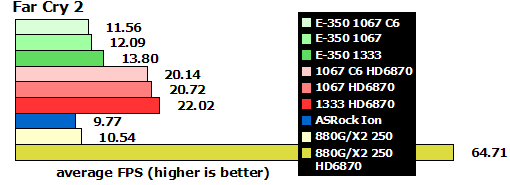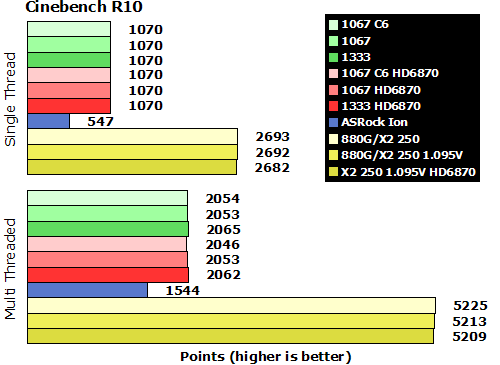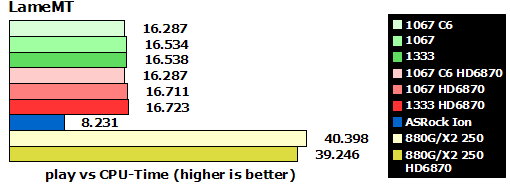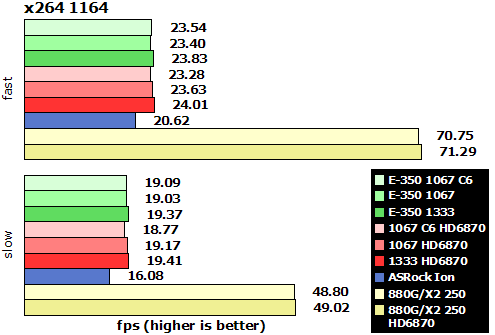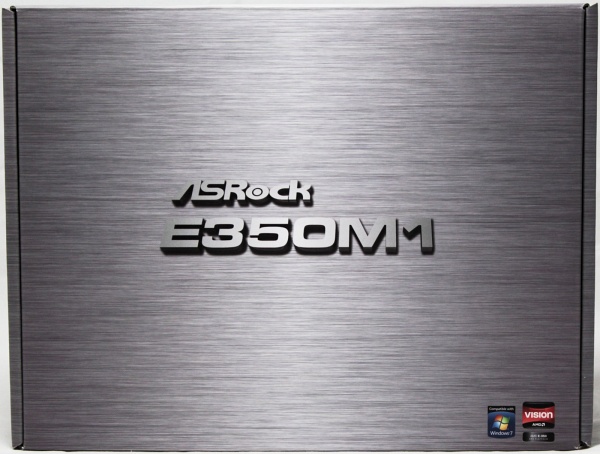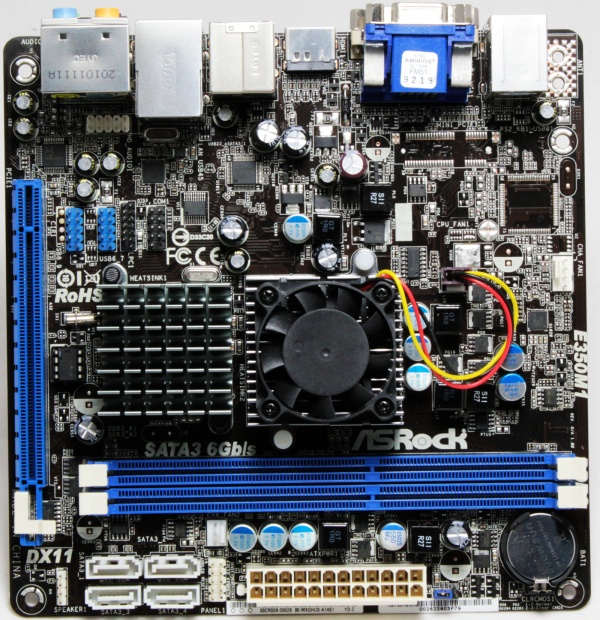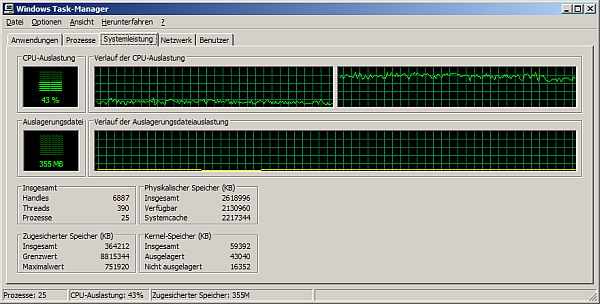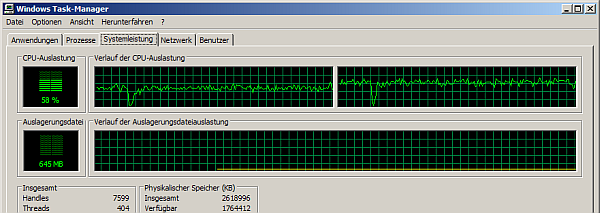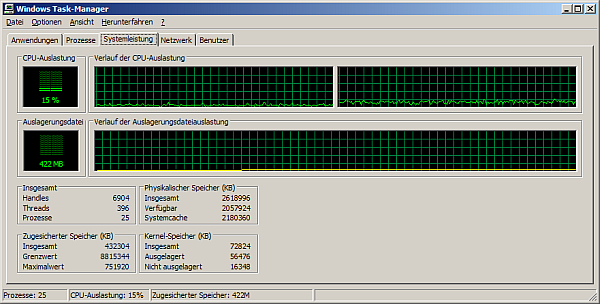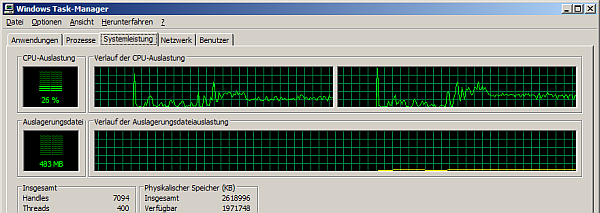Index


Review: Intel Atom is dead
It took AMD quite a long time till Fusion took off, but now it's finally here. Today we will check out how that worked out and if it's any good compared to its direct competition.
Brazos Platform
After taking over ATI there was long talk about "fusing" CPU + GPU on one dice in a monolithic stucture. While Intel used a CPU dice and GPU die and put them into the same package, the AMD approach was more ambitious. A GPU is normaly used to run at high temperatures while CPUs are much more temperature sensitive, combining both is a tricky operation. Now the first product which is now called APU have emerged. While the single core solutions C-30 and E-240 seems a bit 1980's to us, the Zacate APU Dual-Core are more appealing. Truth be told, only the E-350 seems to be a valid option, because the C-50 two cores clocked at 1GHz only impress in tablets or smartphones. (Update: Sorry, there was a bit confusion about the CPU-names.)
The E-350 consits of two CPU cores which are clocked at 1.6GHz, with 32kB L1 Instruction and 32kB L1 Data cache and 512MB L2 cache per Core. In addition you find a derivative of the Radeon HD 5450 inside the APU called Radeon HD6310 with 80 shaders clocked at 500MHz and the UVD3 video decoding engine from the 6-series. Of course the APU features a memory controller but it's limited to two slots and single channel. Besides that, there is a PCIe 2.0 Express hub for four lanes. The whole APU is rated with 18W TDP.
It should not have been so much trouble to integrate the Southbridge into this chip too, but we have to stick with it. Its called Fusion Controller Hub (FCH). It provides all the goodies we need, such as six 6Gbps SATA ports, 14 USB 2.0 ports, two USB 1.1 ports (whoever needs them), four additional PCIe 1.0 lanes. There are other variations which would also include two USB 3.0 ports and Gb LAN MAC, and RAID support but nobody uses them yet. This little piece of silicion adds up another 5W TDP, so the whole platform has a TDP of 23W. In contrast Intel's Atom D525 which clocks at 1.86GHz uses up 13W and the NM10 chipset another 10.6W, quite on par with AMD.
The ASRock E350M1 board
It's an ITX form factor with 17cm on each side with just one PCIe 2.0 x16 slot which of course is only connected with four lanes. The first thing I noticed that this is one of the very few non-solid capactiors designs in the retail market. While it's quite obvious that OEMs will save a cent or two by using cheaper components, it does not make much sense in the retail market, if the price of such board will go up 50 cents more or not, at least for tech savvy customers it wouldn't matter. The APU is covered by a small cooler with an awefully noisy 4900rpm 4cm fan. Interestingly the board features the 24pin power-connector, which could be considerer overkill. Most legacy connectors are gone, but there is still a useless serial connector on the board. The FCH does support six SATA ports, but ASRock only uses five. In the right corner there is empty space for a USB 3.0 chip, so expect this board also with USB 3.0 support after all.
The backpanel is ASRock standard with a useless PS/2 port and more than useless VGA connector. Sorry folks, it just doesn't make sense to convert a digital signal into an analog which is then converted back to digital inside the monitor except you are the rare one still using a Cathode Ray Tube. There would be also be space enough to fit two more USB 2.0 ports.
The BIOS does not support any over-/underclocking or undervoltage capabilities which means the CPU is also locked. You can just enable or disable the CPU sleep mode which does saves a tiny bit of energy, but also does reduce performance a bit. While the CPU officially only supports 1066MHz the latest BIOS we got enabled 1333MHz which does boost performance.
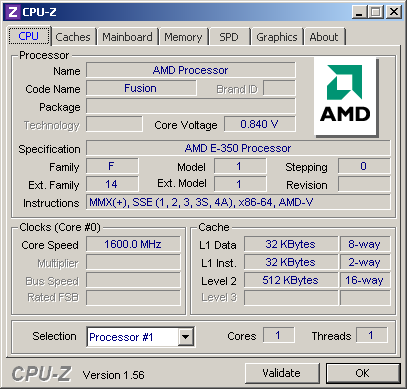
The most use for such an APU besides surfing is of course as an HTPC. With the UVD3 engine it should do all the basic needs. You can just forget about 3D blu-ray, because the APU does not support HDMI 1.4 which is required. We are not fans of the 3D-hype and which of course should be called "fake-3D", so it won't bother us. Also there are restrictions with blu-rays which are encoded with 60fps. The GPU is too weak to manage that, but 24fps is not a problem at all.
Here we played the intro of Spiderman 3 which is very strainful due to the high encoding bitrate of about 45-60Mb/s. With about 38-50% CPU utilization, there is enough room to do other stuff, but who wants that anyways.
More demaning is 1080p with flash. We used a movie trailer on youtube and it goes even higher than a blu-ray disc, which points to a problem with decoding support by flash for AMD graphics, but we are confident they will sort out the problems in the near feature. Regardsless of the higher CPU utilization it was playable without hiccups.
If you have to happen some 1080p material in form of a .mkv file which is normally only encoded with about 10Mb/s then you will not have any problem at all. The CPU cores are not heavily under load at all and peek around 18%.
With common 720p flash videos, the APU peeks around 27% but nothing to worry about.
Normal .avis or other low resulution stuff no problem at all. Of course we tested with Media Player Classic which supports DXVA and is much more usefull compared to Windows Media Player.
Gaming
As you can imagine, this CPU + GPU combination is not meant for gamers. So we won't bother you with meaningless benchmakrs in 800x600 with lowest settings. We benched Farcry 2 in 1280x720 at high and the results are comparable with a very fast slideshow. The fastest results were 13.8 average fps with the APU alone and 22 average fps with a HD6870, so a external graphics-card will not help at all. As you can imagine the CPU is far too underpowered for any playable framerates. If you are a fan of really old games such as Freelancer and it's tons of mods or others, you can play that easily, but any modern game, is just a waste of time.
Power-Consumption
With the 18W TDP you may expect a good efficiency ratio, but here AMD disappoints. With all the hype and PR we have expected much better, but even a quad-core can be more efficient. We have compared the AMD results with the ASRock 330ION-HT box, which of course comes with a 60W external power-supply, while inside the testrig we used a much overpowered 500W PSU which also gives quite bad efficiency with low consumption. We also went shopping to find a combination at around the same price and ended up with an Athlon II X2 250 and a ASRock 880GM/USB3 board. Both are around €20 more expensive then the E350M1 board with APU itself, but a smaller CPU would have only saved €5, so not worth the effort. Even the 880G board with the X2 250 CPU is more efficent, regardsless of using more energy overall.

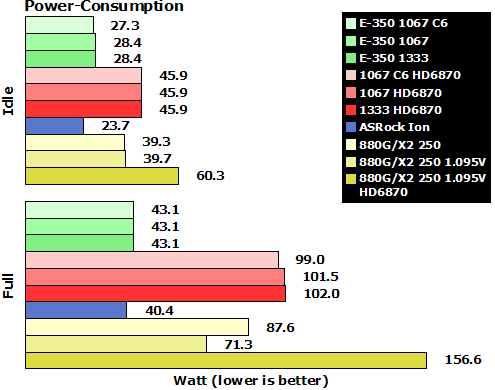
Benchmarks
Before we can draw any conclusions let's see about the overall benchmarks. All the acutal results will be shown after this page. First we have the costs of each platform. Sadly we could not compare the newer Atom D510 and D525 with ION2, but don't expect too much differences with the older Atom 330 silbling. All prices includes a 4GB Kit which is nowadays about €40.
We tested the E350M1 board with the default memory clock of 1067MHz and with C6 deep sleep enabled and disabled. Last week we got a new BIOS which included the 1333MHz memory support which is offically not supported by AMD but did improve the results more than expected.

Conclusion
Brazos Platform:
The results are not stunning or even great, AMD just did ok. While it's not really that much faster compared to Intel's Atom, AMD has one huge advantage - its graphics drivers are not broken. Use it with Windows XP, Windows 7 or Linux it will just work. Do the same with Intel and you can only go for Windows 7 and then the drivers will work only for the most basic functions but even old games may get texture-bugs. Combine a Atom with an ION will work too but it's much more expensive for the manufactures to get. Intel and nVidia could buy the marketshare, but it's seems unlikely they will do that in the lowest margin market anyways. On the other hand AMD has its foot in the door and with it's upcoming quad- and octacores it may become a player in the notebook market again.
In terms of desktops it does all the basic stuff you ask of a computer, it will play your HD content with most of the content besides 3D and if you're thinking for a PC for mum, that's a good way to go. If you casually want to play new games it's much better to go with an Athlon II X2 250 with any 880G board. Combine that with and any 6800 series or the upcoming GeForce 550 Ti card and it will do hugly better. For fifty bucks more you will even get a quad-core Athlon or Phenom which will make gaming even better.
In the future even µATX boards will emerge which is a nice idea, espeically if you have some addin-cards which shouldn't go to waste. But there is a problem called power supplies. With a consumption of about 43W there is no power-supply which will fit. All companies are crazy and going for more Watts than less. The smalles ATX PSUs rate at 250W if you are lucky otherwise you have to go for 300W or even more. Even a 80plus Gold like ours, will suffer efficency on the low load. The crazy designers also got their hands on ITX cases where you also can find 200W and 250W PSUs which is quite ridiculous.
ASRock E350M1:
We are not satisfied with the build quality. We don't like normal capacitors, we don't like push-pins and we especially don't like tiny noisy fans. You can adjust the fan-speed in the BIOS. At level 5 the fan will be still audible but not insanely loud. A bigger cooler with a 6cm would have fitted nicely and would have brought down the noiselevel considerable. I would have invested two bucks more in the BOM but sadly my name is not "Fatality". Besides that, the board did work fine, the 1333MHz memory support does increase the performance and with a price of €87,50 or $99 the board is affordable but not cheap considering the performance. We hope for a ASRock E350M1 Pro board whiich will fix all our complaints and add USB 3.0 support and we would gladly pay €5 more and mum would get a nice new PC.
Due to high demand of E-350 APUs from the netbook and notebook manufactures the retail market will go through some shortages.
Here all the benchmarks:

